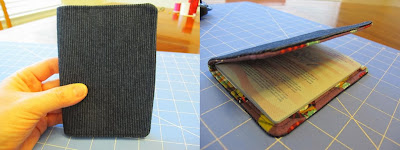I pulled out my scrap fabric boxes and found a heavier weight denim for
the outside of the cover, and light weight cotton for the interior and
sleeves to hold the book in the cover. you also need some heavy fusible
interfacing.
Cut 3: 8 1/4 inch by 5 3/4 inch rectangles from outside fabric, inside
lining and fusible interfacing. This is the body of the book cover.
Cut 2: 5 inch by 5 3/4 inch rectangles from inside lining fabric.
Assembly: Iron the fusible interfacing to the wrong side of the outside
fabric. Fold over the two sleeves to have two pieces 2 1/2 inches wide
by 5 3/4 inches tall.
Top stitch the sleeves at the folded edge--just makes them lay flat and look finished. Sew the sleeve (right side to right side) to the lining fabric, raw
edges to the outside edges of the lining fabric. Use a very narrow
seam--1/8 or close. You can check for the fit, if concerned. You should
have some room to spare.
Now pin the right side of the outside fabric to the right side of the lining. Leaving about 2 to 2 1/2 inches gap, stitch around the edges using a 1/4 inch seam. You can curve the edges or leave them sharp--up to you.
Clip notches in the corners so that they will turn without the bulk of the fabric deforming that nice, clean corner.

Now turn the cover right side out. Just pick a corner and push it through the 2 1/2 inch opening you left when you sewed the layers together. Don't worry about wrinkling--that's what irons are for.
Once you've got it all flattened out and the corners neat, you can topstitch around the edges--though you want to do one last fitting so you know how much of an edge to sew--1/8th or 1/4th.
Your passport book should fit, but not so snug that the book covers bend or the book will not fold closed.
Hurray! Now you have sturdy passport cover. Easy-peasy!























